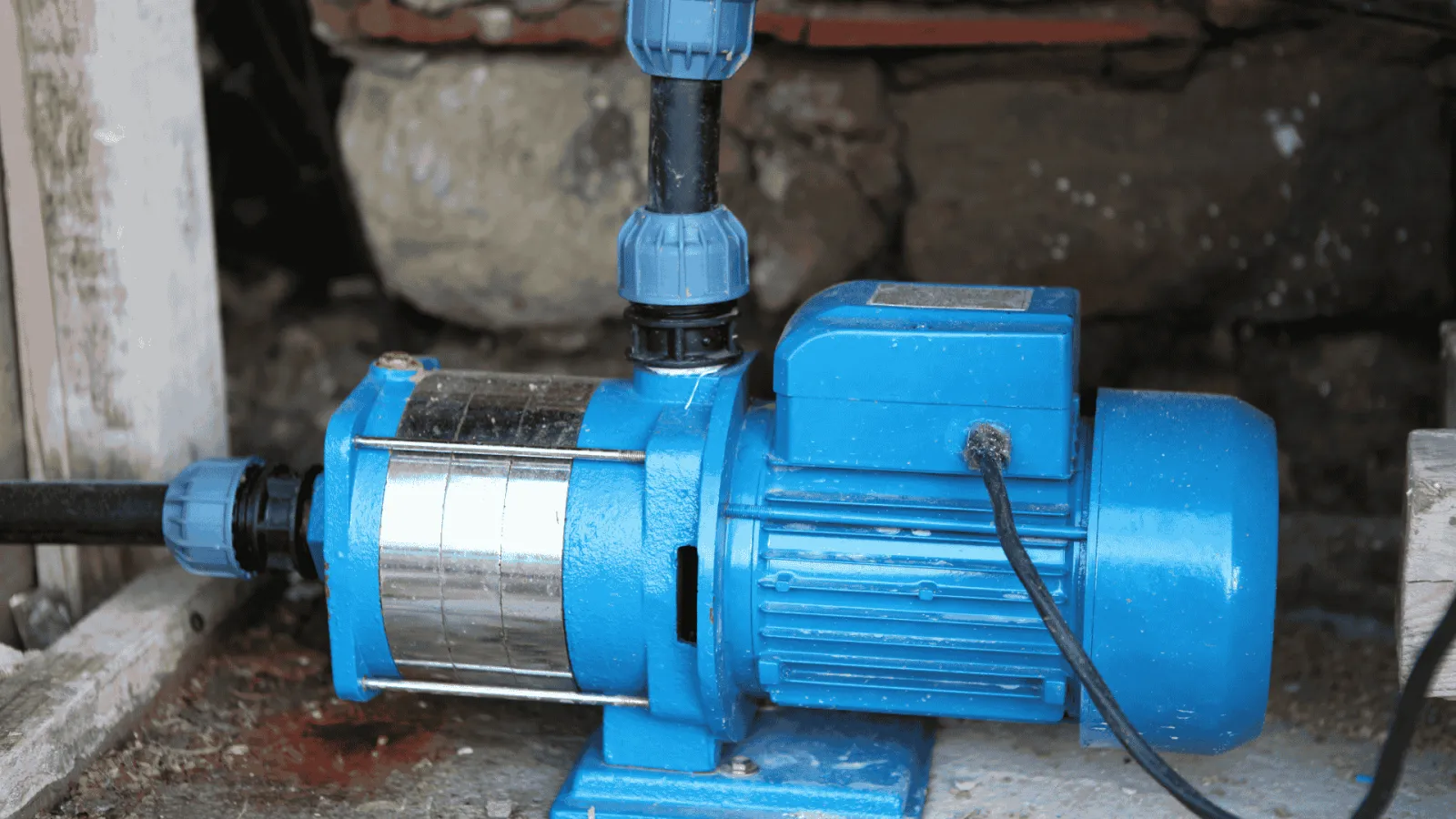Basement waterproofing isn't about stopping water; it's about managing where it goes. A sump pump is a key component of your basement waterproofing system, collecting water that would otherwise flood your basement and pumping it out and away from your foundation.
Quick Answer: What Is a Sump Pump?
A sump pump is an automatic device that removes water from the lowest point in your basement. When groundwater accumulates in a basin (sump pit), the pump activates and directs water away from your foundation through a discharge pipe. Most homes with basements benefit from sump pump installation, especially in areas with high water tables or clay soil.

What Is a Sump Pump?
A sump pump removes water that accumulates around your foundation before it floods your basement. It consists of three essential components:
- The Sump Pump: An electric motor-powered device that moves 2,500-4,000 gallons per hour, depending on horsepower.
- The Sump Pit: A basin recessed into your concrete slab, typically 18-24 inches deep and 18 inches in diameter, with perforated sides allowing groundwater entry.
- The Discharge Line: A pipe (minimum 1-1/4 inches in diameter) carrying water 10-20 feet away from your foundation.
How Does a Sump Pump Work?
Water flows to the lowest point in your basement and into the sump pit. As water accumulates, a float switch rises. When it reaches a preset height, the switch activates the pump motor. The sump pump motor powers an impeller that spins at 3,450 RPM, creating low pressure to draw water through the pump and push it out through the discharge line.
When water drops below the activation point, the float deactivates the pump. A check valve at the base of the discharge pipe prevents water from flowing back into the pit.

Types of Sump Pumps: Submersible vs. Pedestal
Submersible Sump Pumps (Recommended): Located inside the sump pit, completely submerged during operation. They're quieter, more powerful, and longer-lasting because the surrounding water cools the motor. Most models feature cast-iron bases for effective heat dissipation and stainless-steel housing. Ideal for homes with serious water issues.
Pedestal Sump Pumps (Budget Option): Motor mounted above the pit on a pedestal. Less expensive and easier to service, but louder and prone to overheating when used heavily. Works for homes with occasional water intrusion.
Pump Capacity Guide: For most homes, a 3/4 HP pump moving 3,500-4,000 GPH at 10 feet of lift effectively handles the challenges of heavy rainfall and clay soil drainage.
Sump Pump Switch Types
- Tethered Float Switch: Free-floating bulb on a tether. Best suited for wider basins (20 inches or more). Allows for longer cooling periods between cycles, but requires adequate space.
- Vertical Float Switch: Rides up/down a rod. Best for narrow sumps (14-18 inches). It can be obstructed by debris.
- Electronic Switch: Sensors detect water level electronically. Best for debris-heavy environments. Minerals can coat sensors over time.
- Diaphragm Pressure Switch: The switch is activated by water pressure. Most reliable but less common in residential applications.
Do You Need a Sump Pump? 7 Signs
Professional sump pump installation is recommended if you have:
- A basement or crawl space. Below-ground spaces are at risk of water intrusion, especially in areas with clay soil that doesn't drain well.
- Previous flooding or water damage. If you've had standing water or moisture stains, a sump pump is essential insurance.
- A flood-prone neighborhood. Clay soil doesn't absorb water well. If neighbors have sump pumps, you likely need one too.
- A high water table. Groundwater near the surface can push through your basement floor or walls after heavy rain.
- Plans to finish your basement. Protect your investment before water ruins drywall, flooring, and furnishings.
- Insurance requirements. Some policies mandate sump pumps for flood-prone areas or finished basements.
- Seasonal basement dampness. Even without visible flooding, persistent dampness can promote mold growth and lead to foundation deterioration.
Rapid development in many areas increases groundwater levels in surrounding neighborhoods. Homes built 20 years or more ago without water issues may now require sump pumps due to changes in drainage patterns.
Battery Backup Sump Pumps: Essential Storm Protection
Most basement flooding occurs during severe storms that also cause power outages. A battery backup sump pump runs when your primary pump loses electricity, providing critical protection when you need it most.
Battery-Powered Backup: Most reliable option. The separate pump operates on battery power, providing an additional 2,500-3,000 GPH capacity. Deep-cycle marine batteries (75-120 amp-hours) can pump 6,000-13,000 gallons per charge, which is adequate for typical storms lasting 2-4 hours. Replace batteries every 3-5 years.
Water-Powered Backup: Utilizes municipal water pressure (utilizing the Venturi effect) to pump water without the need for electricity. No batteries, but lower capacity (800-1,500 GPH) and consumes potable water. Some municipalities restrict these systems.
Combination Systems: Include primary and battery backup in one unit. Many feature WiFi monitoring for smartphone alerts.
For storm-prone climates, battery backup isn't optional; it's critical protection during severe weather when power outages coincide with peak water intrusion.
Professional Sump Pump Installation
Professional installation takes 4-8 hours. A licensed plumber identifies the lowest basement point, excavates the sump pit, installs the pump, and routes the discharge pipe through your foundation. For significant water issues, interior drain tile (French drains) may be recommended to reduce hydrostatic pressure.
Required Components:
- Discharge Pipe: Minimum 1-1/4 inches diameter, preferably 1-1/2 inches. Schedule 40 PVC for pressure applications.
- Check Valve: Prevents backflow. Replace every 3-5 years. Silencing valves eliminate water hammer.
- Sump Cover: Watertight cover prevents debris, stops radon, and reduces humidity. Include a vent tube (minimum 1-1/4 inches).
- Sump Pump Alarm: Detects overflow and low battery conditions.
- Dedicated GFCI Outlet: A separate circuit prevents voltage drops that shorten pump life.
Cost: Basic sump pump installation costs between $800 and $2,000. Battery backup adds $400-$1,000. French drains typically cost between $3,000 and $8,000. Basement flooding causes $10,000-$50,000 damage per event, and professional installation pays for itself the first time it prevents a flood.
Where Should a Sump Pump Drain?
Discharge water must flow away from your foundation, not back toward it. Professional installers assess:
- Land grade: Discharge where water flows downhill. Ideal slope: 2-3% (dropping 2-3 inches per 10 feet).
- Minimum distance: Local codes typically require a distance of 10-20 feet from foundation walls.
- Yard saturation: Avoid areas with poor drainage or heavy clay soil, as this can cause water recirculation.
- Neighboring property: Don't drain onto sidewalks (freezing hazard) or neighbor's property.
- Storm drains: Many municipalities prohibit direct connections to storm sewers. Never connect to sanitary sewers.
Sump Pump Maintenance
Quarterly Testing: Pour 5 gallons into the pit. The pump should activate within 2-3 seconds, clear water in 10-20 seconds, then shut off automatically. Check the discharge flow outside.
Annual Cleaning (Before Storm Season): Service in late winter or early spring before storm season. Remove the pump, clean the pit and intake screen, wipe the float switch, and inspect the check valve. Remove sediment and debris that reduces capacity by 30-50%.
Check Discharge Line (Spring & Fall): Verify connections are secure, clear obstructions, and check for freezing during cold weather.
Test Battery Backup (Quarterly): Unplug the primary pump and pour water into the pit. Backup should activate immediately. Check battery charge indicators. Replace batteries every 3-5 years.
Common Causes of Failure
- Iron Ochre Buildup: Iron-loving bacteria create rust-colored sludge in iron-rich soil. Requires professional cleaning and more frequent maintenance.
- Inadequate Pumping Power: Undersized pumps can't keep pace with water intrusion. Upgrade to a minimum of 3/4 HP for clay soil areas.
- Faulty Float Switch: Stuck switches can cause continuous operation or prevent activation. Clean quarterly and verify adequate clearance.
- Clogged Discharge Line: Blockages prevent water from exiting. Clear obstructions and install the discharge line heater cable for winter use.
- Broken Check Valve: Allows backflow, causing rapid cycling. Replace every 3-5 years.
- Debris in Impeller: Gravel or sediment jams the impeller. Remove the pump and clear the housing. Install the intake screen.
- Power Failure: Install a battery backup system for storm protection.
When to Replace Your Sump Pump
Sump pumps last 7-10 years with proper maintenance. Replace immediately if you notice:
- Excessive noise: Grinding, rattling, or knocking indicates failing bearings or a damaged impeller.
- Continuous operation: The pump operates continuously, regardless of the water level, even if the float switch fails or the capacity is insufficient.
- No water discharge: The pump runs but doesn't move water. Possible causes include a cracked check valve or a broken impeller.
- Visible rust or corrosion: Iron ochre buildup or extensive rust compromises structural integrity.
- Frequent cycling, occurring every 1-2 minutes, indicates a broken check valve or a stuck float.
- Age over 10 years: Even if operational, internal wear creates a failure risk.
Replacing a failing pump typically costs between $300 and $800. Repairing flood damage costs between $10,000 and $50,000. Preventive replacement is the smart choice.
Protect Your Home from Water Damage
At Dalmatian Plumbing, we combine reliability, speed, and precision to protect Atlanta homes from water damage. With over 75 years of combined experience serving the Metro Atlanta area, our licensed plumbers are well-versed in the local soil conditions and drainage challenges.
We offer comprehensive sump pump installation and repair services throughout Atlanta, Marietta, Roswell, Alpharetta, Sandy Springs, Dunwoody, Decatur, Smyrna, Kennesaw, and surrounding communities. Our services include battery backup systems with WiFi monitoring, French drain solutions, and emergency repairs.
Don't wait until your basement floods. Contact us by phone or schedule your service online. We'll protect your home so you can sleep soundly, even during the worst storms.
Frequently Asked Questions
How much does sump pump installation cost?
The cost of basic sump pump installation ranges from $800 to $2,000. Battery backup adds $400-$1,000. French drains typically cost between $3,000 and $8,000.
How often should I test my sump pump?
Test every 3 months by pouring 5 gallons into the pit. The pump should activate within 2 to 3 seconds. Perform annual cleaning before your local storm season.
Do I need a battery backup for my sump pump?
Yes. Most flooding occurs during storms that cause power outages. Battery backup provides 5-7 hours of runtime, critical protection when you need it most.
What size sump pump do I need?
Most homes require 3/4 HP pumps that move 3,500-4,000 GPH at 10 feet of lift to handle heavy rainfall and clay soil.
How long do sump pumps last?
Sump pumps last 7-10 years with proper maintenance. Replace pumps that are over 10 years old, even if they are operational.
Where should my sump pump discharge?
Discharge at least 10-20 feet from your foundation on a downhill slope. Never discharge into sanitary sewers, as this is prohibited by most local codes.


